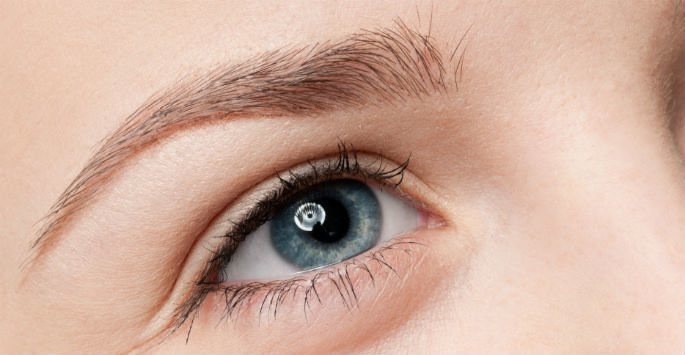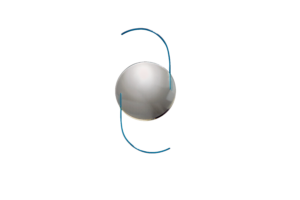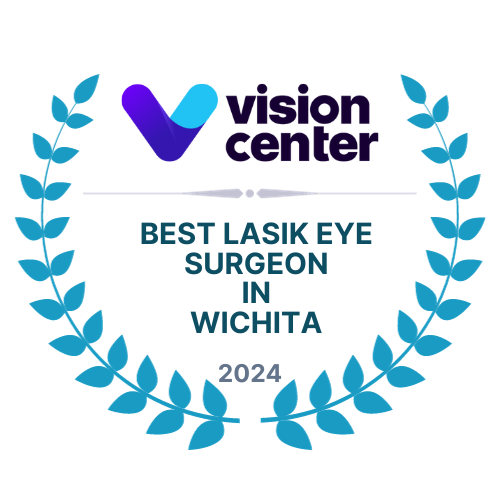
An intraocular lens (IOL) is a small, foldable plastic lens that Dr. Patel uses to replace the eye’s clouded lens during cataract surgery. Prior to intraocular lenses being developed, patients had to wear very thick eyeglasses or special contacts to be able to see after cataract surgery. Now several kinds of intraocular lens implants are available to help people enjoy improved vision with cataract surgery like Monofocal Lens.
Today’s IOLs vary in design and their ability to accommodate different visual needs. Every patient has different needs, so Wichita Vision Institute offers a range of IOLs with unique features. The most common intraocular lenses used by Dr. Patel include monofocal lenses, toric lenses, Ligt Adjustable Lens, and multifocal lenses.
Traditional Monofocal Lens
Monofocal lens improves vision at one distance — either near, intermediate or far. Monofocal lens corrects can correct vision loss due to cataracts. For example, patients with no astigmatism can have excellent distance vision and just need to wear reading glasses for improved near vision (e.g., to read a book or look at a prescription bottle). Patients with astigmatism who elect to have a monofocal lens implant will usually have to wear glasses and/or contacts for most everyday activities because the traditional monofocal lens does not correct astigmatism or presbyopia.
Dr. Patel prefers using the AcrySof IQ and TECNIS lenses for monofocal correction. The AcrySof lens includes a yellow filter, which may protect the eye’s retina from UV exposure and other potentially damaging light radiation. Over 70,000,000 AcrySof IQ lenses (which include monofocal, multifocal, and toric lenses) have been implanted worldwide.
The TECNIS lens is the first and only wavefront-designed IOL with FDA approval for reducing spherical aberration, improved functional vision, and improved night driving simulator performance. The TECNIS one-piece lens has a specially-designed frosted edge to minimize unwanted edge glare. Should you decide to proceed with cataract surgery and a monofocal lens implant, Dr. Patel will determine which intraocular lens will best suit your visual needs after extensive pre-operative measurements, examinations, and in-depth discussions with you are performed.
Toric Intraocular lenses
Toric intraocular lenses are uniquely designed for patients who desire improved uncorrected distance vision, reduction in astigmatism and increased independence from glasses for distance vision. Astigmatism is a common visual condition where the eye’s cornea or lens is irregularly curved, resembling more of an oval than a sphere. Astigmatism causes blurred vision and the distortion of images at all distances. Toric lenses can restore clear vision in patients with corneal astigmatism and/or lenticular astigmatism. Dr. Patel uses advanced IOLs such as the AcrySof IQ toric IOL and the TECNIS toric IOL to help provide excellent vision and a decreased dependence on glasses or contacts after cataract surgery.
Light Adjustable Lens
The RxSight™ Light Adjustable Lens is the first and only intraocular lens (IOL) that can be customized after cataract surgery. The Light Adjustable Lens is made of a special photosensitive material that can be adjusted in response to ultraviolet (UV) light. This optimization is done by Dr. Patel in the weeks following lens implantation through a series of non-invasive light treatments that take only a few minutes each. You will have the unique ability to adjust and preview your vision until it meets your personal desires and lifestyle requirements. The Light Adjustable Lens delivers superior vision outcomes that non-adjustable IOLs cannot match. Learn more about the Light Adjustable Lens in Wichita.
Multifocal Intraocular Lenses
The original multifocal lens, ReSTOR was designed to improve vision at multiple distances. With the unique features of the ReSTOR lens, patients experience a full range of clear vision without the need for reading glasses. ReSTOR lenses are commonly used for patients with presbyopia.
There are three versions of ReSTOR lenses currently approved by the U.S. Food and Drug Administration. The original non-aspheric version is based on diffractive technology, which directs light in different ways depending on where the light falls on the different zones of the lens. Diffractive lenses provide great near and distance vision, with less emphasis on intermediate vision.
The newer aspheric AcrySof IQ ReSTOR lens enables better vision at all three distances. It also provides better contrast sensitivity. ReSTOR lenses include a yellow filter, which may protect the eye’s retina from UV exposure and other potentially damaging light radiation. Studies show that four out of every five AcrySof IQ ReSTOR recipients reported never wearing glasses after having the lens implanted in both eyes.
Approved by the FDA, the TECNIS multifocal IOL provides good near, intermediate, and distance vision, even in low-light conditions. Most patients with TECNIS multifocal IOLs are able to read in low-light conditions and drive at night without severe halos or glare. TECNIS lenses are reliable, stable, and restore a patient’s vision back to its prime.
TECNIS multifocal lenses are engineered using WaveFront technology, in which the cornea and crystalline lens of a representative population sample are scanned to obtain measurements. Unlike other IOLs, the TECNIS multifocal IOL addresses and corrects spherical aberration in the cornea to provide sharper vision in low-light situations. The TECNIS multifocal lens is also pupil-independent which means sharper near vision in low light conditions. The TECNIS multifocal lens is clear, so it provides full transmission of healthy blue light, which can be essential for optimal low-light vision. Nearly nine out of 10 patients who have had the TECNIS multifocal IOL implanted never wear glasses. Nearly 90% of patients with the TECNIS multifocal lenses in both eyes are able to function comfortably without glasses at all distances.
Monovision Option
Some patients elect to have one eye corrected for distance vision and one eye corrected for near vision, which is called monovision. Depth perception may decrease with this option due to less binocular vision, because your eyes are not working together. The patients that do best with this method are those who have already used monovision with contact lenses. It is not suitable for everyone as some people have difficulty adjusting to this situation and notice blurred vision at both near and far distances.
Studies have shown that the aforementioned IOLs receive high patient satisfaction ratings. If you and Dr. Patel decide that cataract surgery is right for you, she will recommend the intraocular lenses that works best for your individual vision needs.
Symfony® and Symfony® Toric Premium Intraocular Lenses
Designed to improve everyday life for men and women with cataracts, Symfony® lenses offer continuous, high-quality vision, excellent vision in any lighting condition, and a lens for life. Dr. Reena Patel has the distinction of placing the first Symfony® lens on a patient in Wichita and is highly trained on its implementation and use. In addition, Symfony® lenses offer high-quality vision even in low-light conditions. Activities such as walking at dusk, going to the movies or even driving at night can now be possible with Symfony® lenses.
Contact us today to find out which lenses are right for you!









